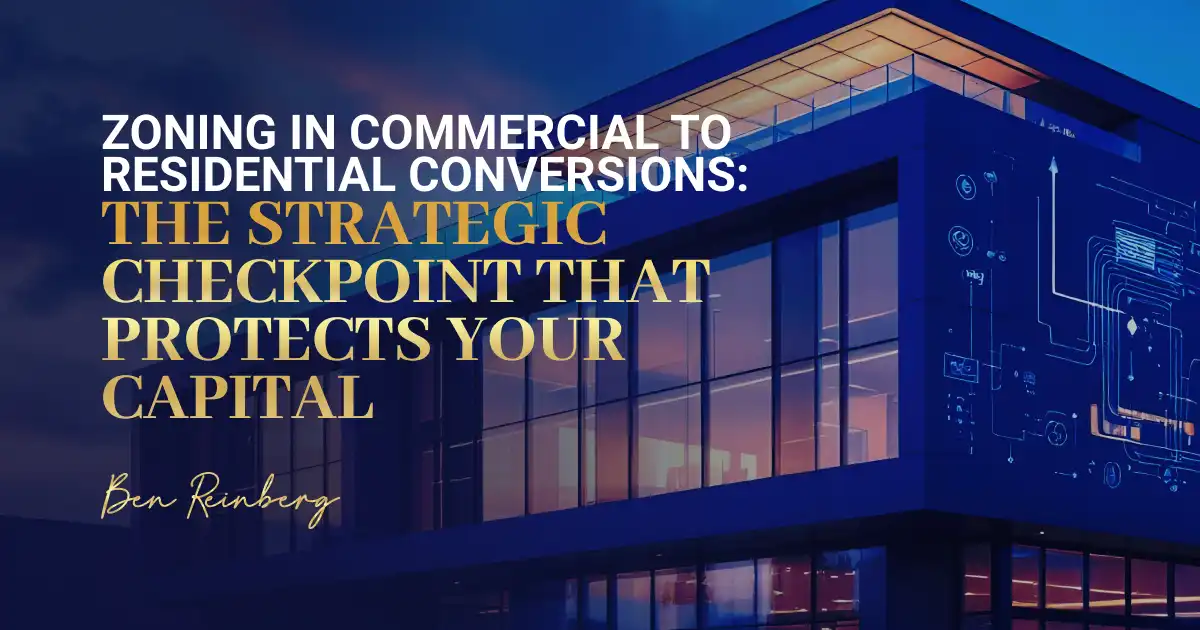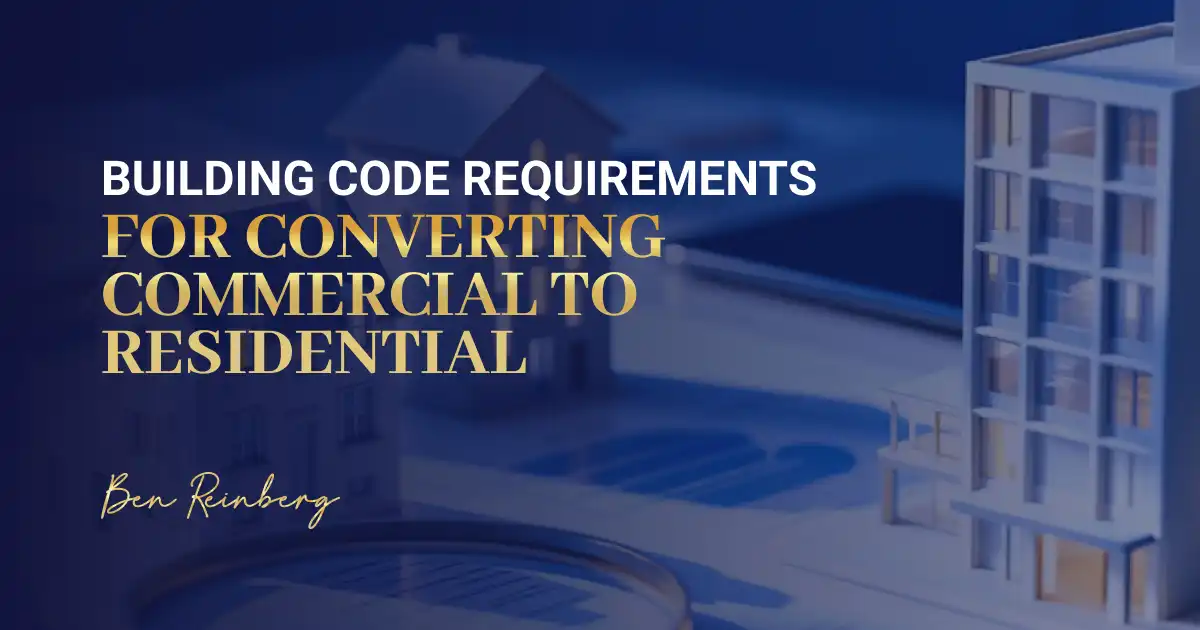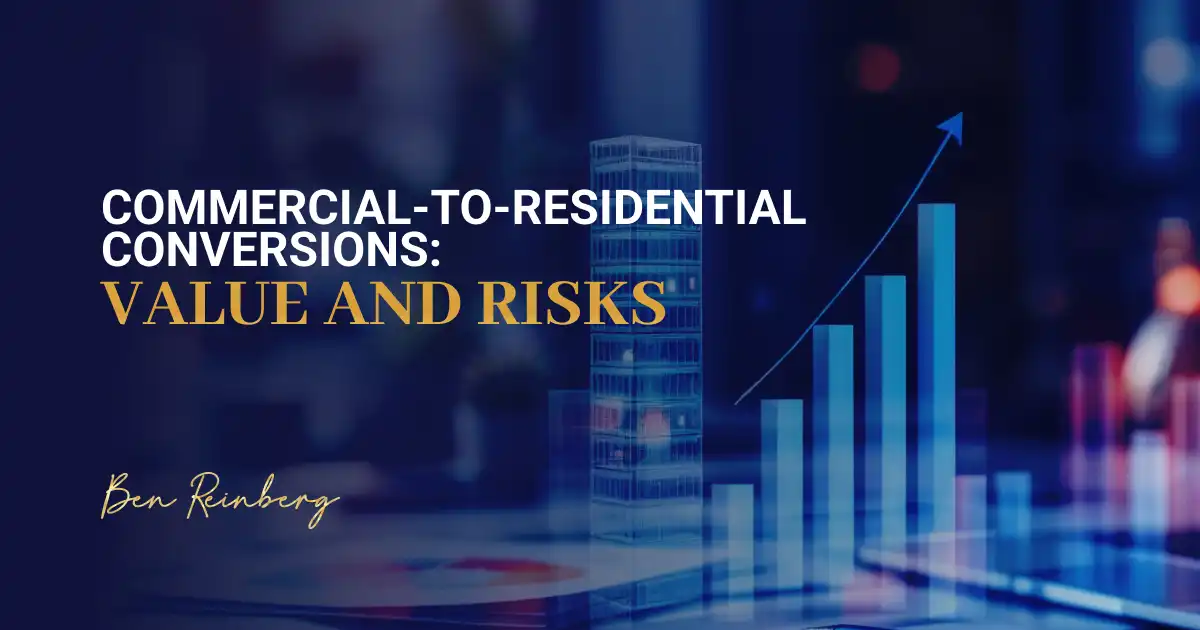
Why Real Estate is the Foundation of Wealth Creation
March 13, 2024
Discover the transformative power of a wealth mindset in real estate investment.
Read More >>>
Commercial real estate (CRE) has long been a proven way to build wealth. With housing demand rising and office/retail vacancies increasing, more investors are asking if commercial properties can be used for residential purposes. Adaptive reuse is no longer just a creative idea; it’s become a practical strategy to unlock value. Atlanta has seen a 57% year-over-year increase in office-to-residential conversions, a clear signal that this trend is scaling in major United States markets.
Renting or converting commercial property into residential space is possible, but it isn’t as simple as putting up a “for rent” sign. Success depends on understanding zoning restrictions, building code compliance, financing structures and how these choices affect net operating income (NOI). Without that preparation, a promising opportunity can quickly become a costly challenge.
The investors who succeed approach conversion with discipline. They transform underutilized assets into steady income, strengthen valuations and build portfolios that can weather multiple market cycles. With the right expertise and perspective, what seems complex at first becomes a path to reliable cash flow and long-term wealth creation.

Any plan to use a commercial property for residential purposes begins with zoning laws. Local governments classify properties as commercial, residential or mixed-use, and trying to operate outside those rules without approval can trigger fines, lengthy delays or legal challenges that eat into returns.
In some cities, mixed-use zoning already permits apartments above retail or office spaces. In others, a conversion only moves forward after a rezoning process or a conditional-use permit is approved. Skipping this step isn’t an option; it can make the difference between a profitable deal and a stalled investment.
The most astute investors view zoning as a strategic checkpoint, not an afterthought. Reviewing commercial vs. residential property classifications helps clarify which opportunities are viable, while federal resources, such as the U.S. Environmental Protection Agency's (EPA’s) zoning and smart growth guide, show how regulations influence redevelopment at scale.
By addressing zoning up front, investors protect their capital, move through approvals with greater confidence and concentrate on properties that can deliver steady income and long-term value. That disciplined approach is what separates opportunistic guesses from strategies that build durable wealth.

Once zoning is in place, the next step is ensuring the property meets building code requirements. These codes establish the standards that ensure a space is safe, livable and compliant with legal requirements for tenants. Properties that meet or exceed code not only lease faster but often command premium rents in competitive markets, directly impacting long-term returns. For most commercial-to-residential conversions, that means updates such as:
These improvements often come with added costs, but seasoned investors recognize them as investments in the property’s long-term value. By addressing building code compliance early, you avoid setbacks, protect your capital and create a more marketable asset.
The most effective approach is to build a comprehensive picture of the property up front. A due diligence checklist ensures that nothing gets overlooked, while understanding property valuation methods shows how upgrades directly translate into stronger performance over time.
Handled with foresight, building code compliance becomes more than a requirement; it’s part of a disciplined strategy that creates safer spaces, attracts reliable tenants and supports a portfolio built for resilience and growth. This is the type of structured, forward-looking approach that defines authentic leadership in CRE investing.

When converting a commercial property to residential use, investors need to examine the numbers closely. The financial outcome depends on how well the following factors are addressed:
Disciplined modeling leads to more substantial investor confidence and better loan terms. By taking a structured approach to NOI, depreciation and financing, investors turn financial challenges into opportunities. This not only protects capital but also strengthens valuations, supports consistent income and builds portfolios designed to perform across market cycles.

Converting commercial property into residential use is one of the most effective ways to unlock new value, especially when the project is grounded in strong market fundamentals. With thoughtful planning, adaptive reuse transforms underused buildings into steady income-producing assets and supports long-term portfolio growth.
Opportunities tend to stand out in places where:
Still, conversions aren’t without risks. The most common challenges include:
The investors who excel are those who approach these projects with discipline and diligence. They test their financial models against multiple outcomes, use conservative debt structures to stay flexible and build due diligence into every step of the process. Market outlooks, such as the Commercial Real Estate Industry Outlook, and research on high-growth markets in 2025, point to regions where fundamentals support conversions. Meanwhile, proven approaches to protecting CRE investments demonstrate how disciplined strategies preserve capital and strengthen returns.
Handled with foresight, commercial-to-residential conversions are more than just a response to vacancies; they’re a way to unlock reliable cash flow, enhance property values and build portfolios designed to thrive across market cycles.

If you’re considering renting commercial property for residential use, a structured process helps you move forward with clarity and confidence. Each step builds on the next, protecting your capital and improving your chances of long-term success.
“Value is created when preparation meets market opportunity.”
Check how the property is classified with the municipal authorities. If it’s not zoned for residential use, explore rezoning or conditional-use permits before investing further.
Residential conversions require higher standards than offices or retail. Plan for fire and safety systems, plumbing, ventilation and HVAC upgrades to meet code requirements and ensure the property's livability.
Build projections that include retrofitting costs, financing terms and realistic rental income. Grounding NOI in market realities prevents inflated expectations.
Review legal, financial and operational details, title checks, lease audits and expense reviews to confirm the property can truly support your strategy.
Leasing strategy directly impacts conversion outcomes. Investors often benefit from reviewing a step-by-step guide to leasing commercial property, which helps align tenant expectations and maximize long-term returns.
Conversions can be complex. Surround yourself with professionals who understand zoning, financing and asset management to navigate challenges and uncover opportunities others might miss.
Tie it all back to execution. Securing financing aligned with your conversion plan and pairing it with a clear leasing strategy creates stable cash flow and strengthens asset value over time.
Adaptive reuse isn’t a workaround; it’s a proven wealth-building strategy. Ben Reinberg has built a $500M+ CRE portfolio with a 28% historical internal rate of return (IRR) over three decades, proving that disciplined underwriting, conservative structuring and forward-looking strategy transform underutilized properties into high-performing assets.
Converting commercial property into residential use isn’t just about repurposing space; it’s about creating steady cash flow, stronger valuations and portfolios that perform across every market cycle. With disciplined execution, adaptive reuse turns complexity into a long-term opportunity.
Become an investor today and align with proven strategies that deliver resilient cash flow, stronger valuations and lasting portfolio growth.
Absolutely, but only if you follow the rules. I’ve seen investors fail because they skipped zoning or code compliance. Some cities allow mixed-use setups (like apartments above retail), but in many markets you’ll need rezoning or conditional-use permits. Follow the process, and you unlock significant income potential by transforming underutilized spaces into a steady cash flow and long-term value.
Cutting corners here will cost you. Noncompliance can trigger fines, stop-work orders or block you from leasing units altogether. Worse, sloppy upgrades eat into NOI and delay returns. Savvy investors know code compliance isn’t a hurdle; it’s how you protect capital, attract quality tenants and build assets that hold value over time.
Yes, but not by just throwing up a “For Rent” sign. You need the proper approvals and upgrades first. Skipping permits exposes you to lawsuits and financial losses. When done correctly, renting converted commercial space is one of the most effective ways to diversify income, improve occupancy and enhance portfolio performance.
Think discipline, not shortcuts. Here’s the process I walk investors through:
Conversions aren’t quick flips; they’re structured projects. Treat them with discipline, and you transform complexity into reliable cash flow and long-term wealth.
